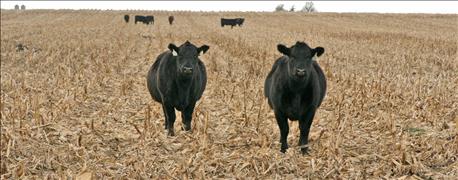
Most beef cattle producers do not weigh their cows on a regular basis. Still, they need to be able to evaluate their condition to ensure proper nutrition. Enter the body condition score (BCS).
For decades, university livestock Extension specialists and veterinarians urged beef cattle producers to use body condition scores to visually appraise their cattle in the pasture or feedlot. But what exactly are cattle producers looking for? What is a BCS?
Multiple sources, same takeaway
Many university researchers and livestock specialists have weighed in on exactly what a BCS is. Here are a few of their definitions.

FIT CATTLE: Assessing the body condition of a cow is important moving into the cold winter months. A body condition score allows farmers and ranchers to know just how much energy a cow has stored, and how much feed she will need to thrive during the cold winter months.
• According to University of Nebraska-Lincoln beef specialist Rick Rasby, a body condition score describes "the relative fatness or body condition of a cow herd through the use of a nine-point scale. A body condition score five (BCS 5) cow is in average flesh and represents a logical target for most cow herds. A BCS 1 cow is extremely thin, while a BCS 9 cow is extremely fat and obese." Read more at beef.unl.edu/learning/condition1a.shtml.
• Virginia Cooperative Extension defines body condition scores as "numbers used to estimate energy reserves in the form of fat and muscle of beef cows. BCS ranges from 1 to 9, with a score of 1 being extremely thin, and 9 being very obese. Areas such as the back, tail head, pins, hooks, ribs and brisket of beef cattle can be used to determine BCS. Read more at pubs.ext.vt.edu/400/400-795/400-795.html.
• Putting it simply, the University of Georgia Extension says, "Body condition scoring is an easy and economical way to evaluate the body fat percentage of a cow." Read more at extension.uga.edu/publications/detail.cfm?number=B1308.
The takeaway — body condition scoring looks at fat on cows. But just where should farmers and ranchers look for fat deposits?
Know your anatomy
To assess cattle for body condition, cattle producers must know where the muscle and fat are positioned on the animal. They must also be familiar with the skeletal makeup of a cow. The University of Georgia Cooperative Extension offers a quick and simple look at the cow's skeletal structure to give producer a starting point.
There are roughly six areas on the cow to look at when using BCS:
1. Back
2. Tail head
3. Pins
4. Hooks
5. Ribs
6. Brisket
Virginia Cooperative Extension shows just where these are located on its website and in the drawing below.

A BCS VISUAL: Here are areas useful for visually determining body condition score in beef cows. (Courtesy of Oklahoma State University)
There are also websites that offer help with BCS by using photographs of cattle. Here are a few you might find helpful:
• Texas A&M University offers photos by breed influence including Brahman, Continental and English. See vernon.tamu.edu/center-programs/range-animal-nutrition-program/decision-aids-for-cattle-producers/body-condition-scoring-photo-guide/photo-guide-to-body-condition-scoring-beef-cattle.
• North Dakota State University offers a printable PDF to take to the pasture or feedlot. See www.ag.ndsu.pubs/ansci/beef/as1026.pdf.
• Body Condition Scoring: The Cattle Producer's Resource of the Angus Journal offers photos along with articles on BCS. See cowbcs.info/photogallery.html.
Now that you know what BCS is and how to assess it, what does it all mean?
Why bother with BCS?
According to Rasby, "Body condition scoring of cattle allows cattle producers to assess the level of fat reserves of cows during various production phases. When regularly used, this information can be used to formulate management and feeding decisions."
The goal of BCS is for cattle producers to be able to determine a cow's nutritional needs without running them across the weight scale.
Over the years, the BCS score has proven extremely useful. It is crucial information when it comes to getting cattle through harsh winter months.
Research has shown that cow BCS is related to the postpartum interval, rebreeding performance and the quality of colostrum the cow produces for its newborn calf.
Bottom line — a cow body condition score measurement is an important task on any beef cattle operation.
About the Author(s)
You May Also Like






